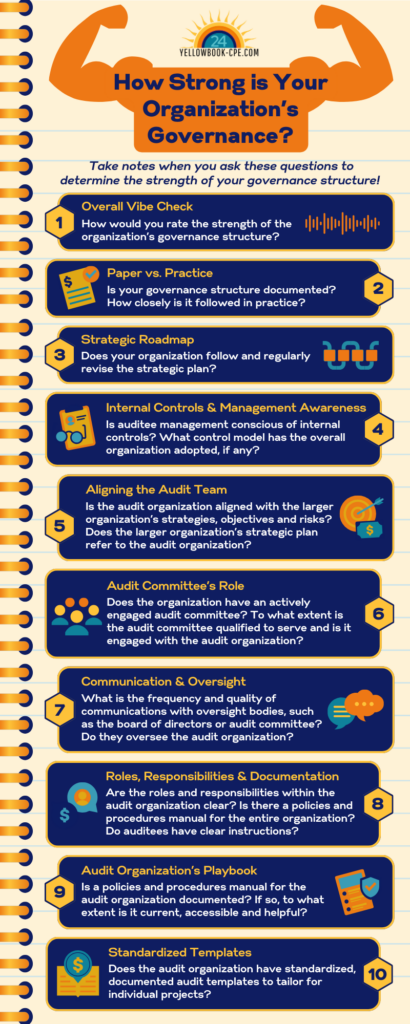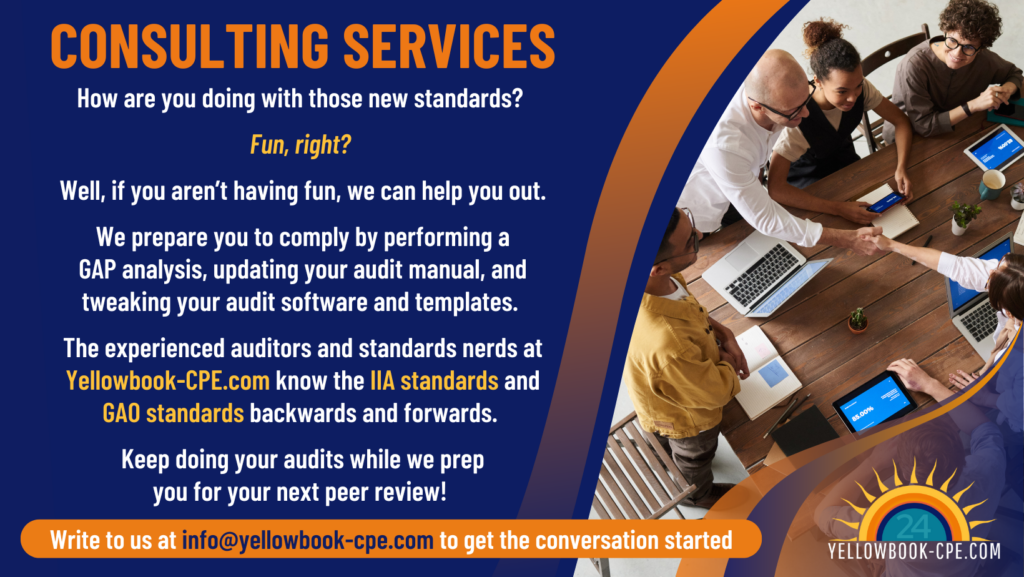Evaluating your audit organization’s governance might not sound like the most thrilling activity. However, it’s crucial for ensuring everything runs smoothly.
Think of it as checking the health of your organization’s inner workings. You want to know if everything functions as planned and if the rules are being followed.
So, here’s a guide to figuring out just how strong your governance structure really is, with a touch of humor to keep things interesting!
1. Overall Vibe Check
- How would you rate the strength of the governance structure of the organization? Start with a general vibe check. Is your governance setup more like a well-oiled machine or a comedy of errors? Then give it a rating to get a sense of where you stand.

2. Paper vs. Practice
- Is your governance structure documented? A written record is like a rulebook. If you don’t have one, it’s like trying to navigate a maze with no map!
- How closely is the governance structure followed in practice? On a scale from 1 (just words on paper) to 5 (everyone’s following the same game plan), how well is your governance being put into action? This helps you figure out if it’s all talk or if the team really plays by the rules.
3. Strategic Roadmap
- Does your organization follow a strategic plan? A strategic plan is your blueprint for success. Check if your organization has one and if it’s guiding the big decisions – or if it’s just collecting dust on a shelf.
- Does your organization regularly revise the strategic plan? Just like strategies need to evolve, so should your strategic plan. See if your plan receives regular updates or if it’s stuck in a time warp.
4. Internal Controls & Management Awareness
- To what extent is auditee management conscious of internal controls? Management’s awareness of internal controls is crucial. How well do they understand and follow these rules? Particularly, are they champions or just along for the ride?
- What control model has the overall organization adopted, if any? Identify the control model your organization uses. It’s like knowing which playbook you’re following. By comparison, you’ll know whether it’s a classic or something straight out of left field.
5. Aligning the Audit Team
- Is the audit organization aligned with the larger organization’s strategies, objectives and risks? The audit team should be in sync with the rest of the organization. Check if their goals and activities match up with the overall strategy or if they’re playing a different game altogether.
- Does the larger organization’s strategic plan refer to the audit organization? See if the big-picture plan includes the audit team. It’s like having a strategy that includes everyone or if the audit team just sits on the sidelines.
6. Audit Committee’s Role
- Does the organization have an actively engaged audit committee? An active audit committee is like a coach who’s actually coaching. Assess how involved and engaged they are in the process.
- To what extent is the audit committee qualified to serve on the audit committee? Check out the qualifications of your audit committee members. For instance, are they the all-stars of the field or just amateurs who wandered in from the stands?
- To what extent is the audit committee engaged with the audit organization? Determine how well the audit committee interacts with the audit organization. Do they schedule regular strategy sessions or is it more of a “see you at the end-of-season party” scenario?
7. Communication & Oversight
- To what extent is the frequency and quality of communications with oversight bodies, such as the board of directors or audit committee? Good communication is key to running a tight ship. For example, assess how often and well the organization communicates with oversight bodies like the board of directors. Do they chat regularly or just send the occasional postcard?
- To what extent does the governing body perform oversight of the audit organization? Evaluate how the governing body keeps an eye on the audit team. Do they make sure the team sticks to the rules, or is it more of a “hope for the best” situation?
8. Roles, Responsibilities & Documentation
- To what extent are the roles and responsibilities within the audit organization clear? Clear roles are like knowing each player’s position on the field. Check if everyone knows their role and responsibilities – or if they just improvise.
- Is there a documented policies and procedures manual for the entire organization? Obviously, a documented manual is like having a detailed game plan for the whole team. See if there’s a comprehensive guide to follow or if it’s more of a “wing it” approach.
- To what extent do auditees have clearly documented policies and procedures for the functions they’re responsible for? Specifically, auditees should have their own playbooks for their specific functions. Check if they have clear and documented policies or if they just make it up as they go along.
9. Audit Organization’s Playbook
- Is a policies and procedures manual for the audit organization documented? Check if there’s a manual specifically for the audit team. After all, it’s like having a specialized playbook just for them.
- To what extent is the audit policies and procedures manual current? An up-to-date manual is like having the latest game strategies. See if the manual is current and relevant or if it’s stuck in the past.
- Is the audit policies and procedures manual accessible? Ensure the manual is easy to access. It’s like making sure the playbook is available to all team members and not filed away on one auditor’s local hard drive.
- To what extent is the policies and procedures manual helpful? A helpful manual makes for smoother operations. Therefore, determine if the manual is practical and useful or if it’s more of a “just for show” document for peer reviewers.
10. Standardized Templates
- Does the audit organization have standardized, documented audit templates to tailor for individual projects? Standardized templates are like having pre-set game plans to adjust as needed. Check if your audit organization has customizable templates for specific projects or if they just improvise each time. Additionally, standardized templates prevent the audit team from reinventing the wheel on each audit and helps your team comply with standards.
To summarize, evaluating your governance structure doesn’t have to be a chore. By asking these questions, you’ll get an insightful look at the strength of your governance setup So, grab your metaphorical clipboard, and let’s see if your audit organization is ready for the big leagues!
Yellowbook-CPE helps your audit team succeed!
Yellowbook-CPE developed an innovative new assessment tool named DART to evaluate your internal audit organization on 13 different dimensions.
Those dimensions comply with IIA and GAGAS standards, and address organizational maturity and risk management practices. At the same time, this assessment finds new opportunities for improvement.
DART aids you and your organization to discover new ways to meet the changing role of your audit shop. Also, you receive the team benefit of experienced internal auditors, trainers and leaders who have overcome the same challenges you currently face.
Additionally, we prepare you for peer reviews and update your audit manuals, tools and audit software to comply with audit standards.
For more information contact us at info@yellowbook-cpe.com or call 979-4YELLOW (979-493-5569). We look forward to working with you!

Want to learn more?
Then look no further than Leading an Audit Project scheduled for October 21-25! In this exclusive webinar series spanning 5 consecutive afternoons, learn practical, repeatable – and most importantly! – immediately applicable strategies to direct and energize your audit team while elevating your skills as a servant leader.
Two powerful and insightful instructors share their best ideas for supporting a productive and congenial audit team. Leita Hart Fanta, CPA addresses the nuts and bolts of managing an audit project while Clint Reese encourages audit leaders to guide their team from a solid core based on values and trust.
Come prepared to look at yourself, your team, and the environment you operate in in new ways.
As an added bonus, you will have the opportunity to delve into objective setting and audit findings ahead of the course and earn 4.5 extra hours of CPE.

 Yellowbook-CPE.com is registered with the National Association of State Boards of Accountancy (NASBA) as a sponsor of continuing professional education on the National Registry of CPE Sponsors. State boards of accountancy have final authority on the acceptance of individual courses for CPE credit. Complaints regarding registered sponsors may be submitted to the National Registry of CPE Sponsors through its website:
Yellowbook-CPE.com is registered with the National Association of State Boards of Accountancy (NASBA) as a sponsor of continuing professional education on the National Registry of CPE Sponsors. State boards of accountancy have final authority on the acceptance of individual courses for CPE credit. Complaints regarding registered sponsors may be submitted to the National Registry of CPE Sponsors through its website: